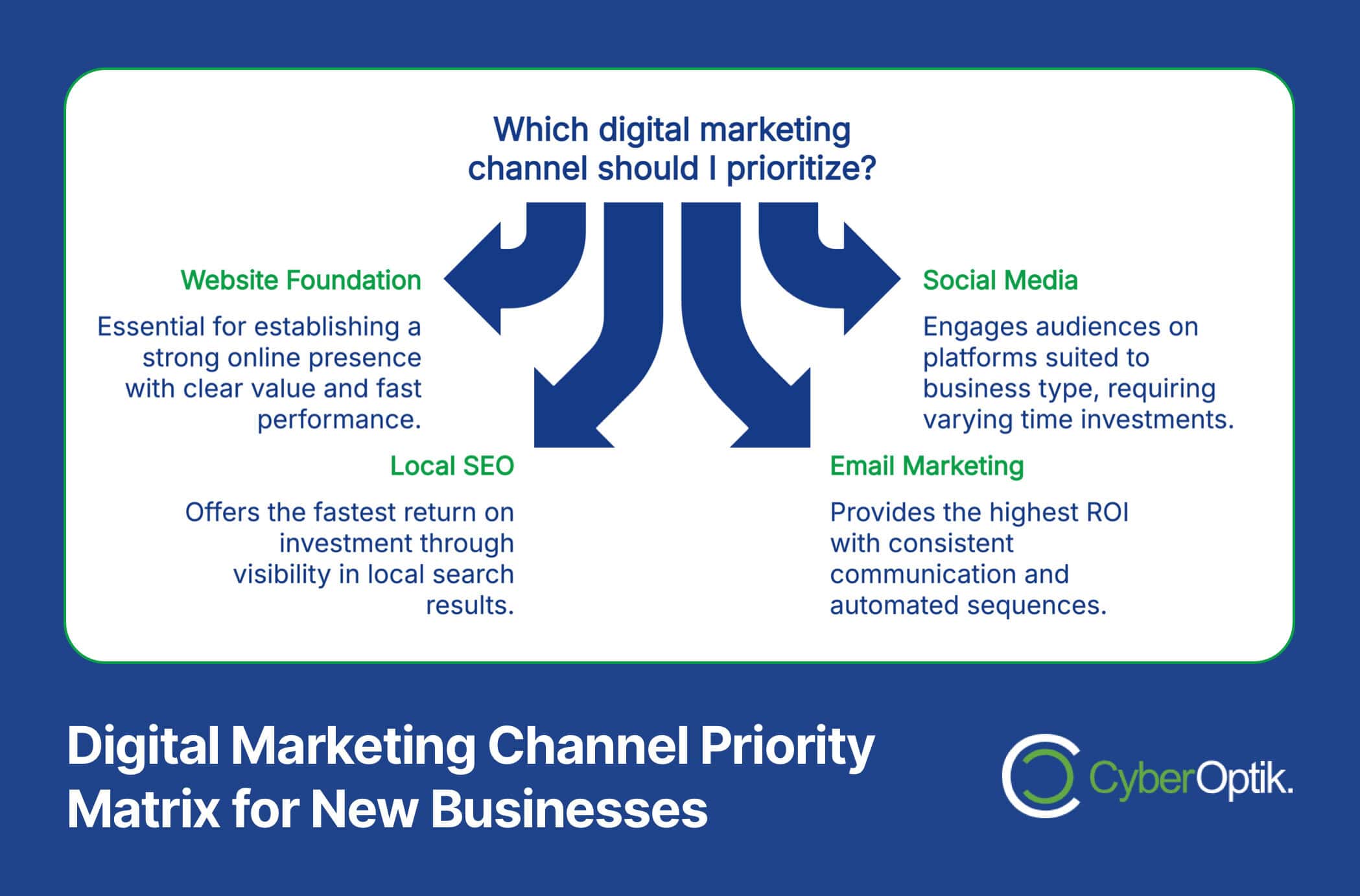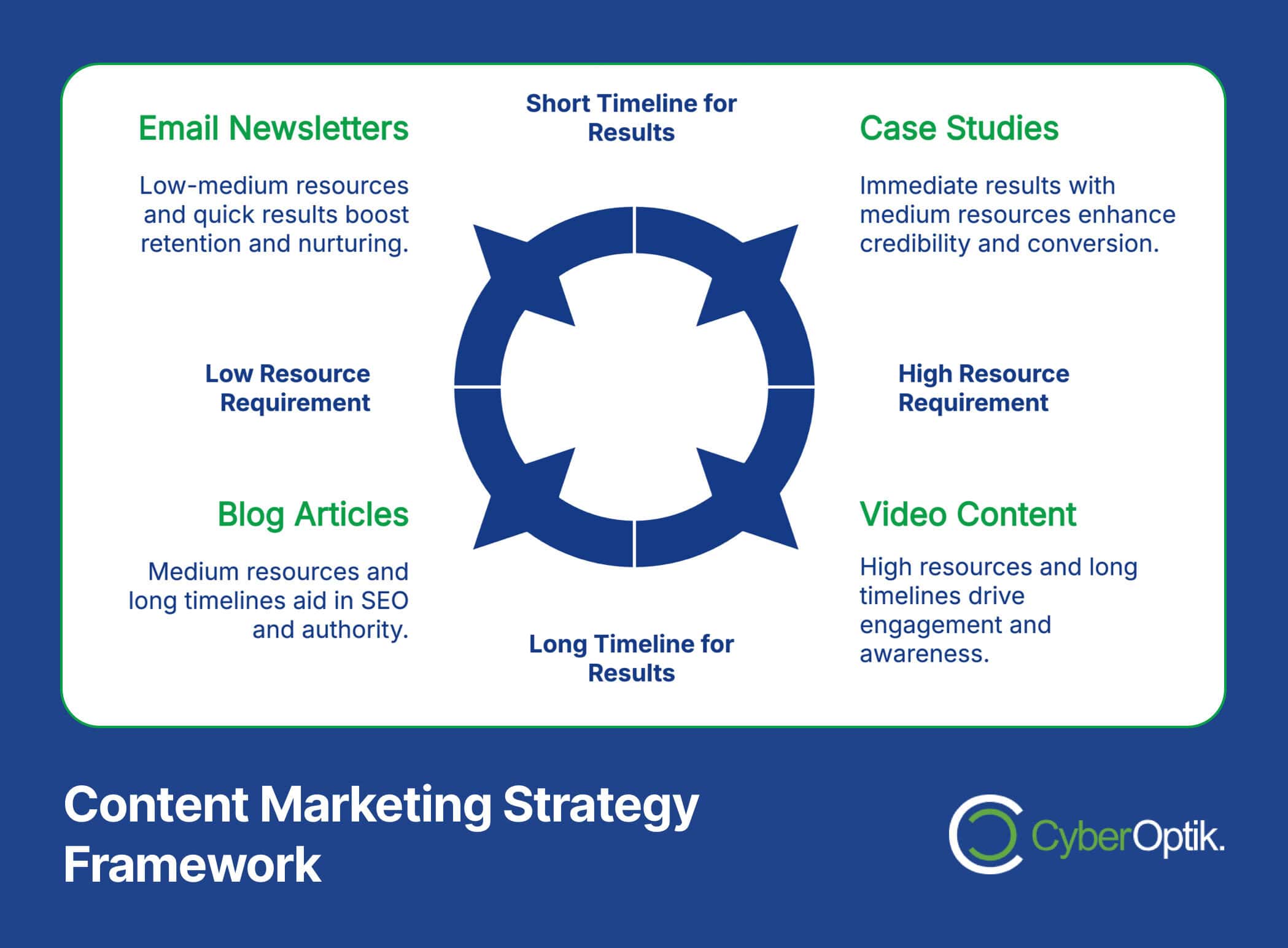Starting a new business is exhilarating. The marketing decisions you make early on can determine your trajectory for years to come. Many new business owners feel overwhelmed by marketing options. We understand this challenge intimately.
At CyberOptik, we’ve helped numerous Chicago businesses establish their digital presence from the ground up. We’ve seen which marketing strategies consistently deliver results for new ventures. This guide focuses on practical, proven approaches.
Whether you’re operating on a shoestring budget or have some capital to invest, implementing the right marketing mix makes all the difference. Let’s explore the strategies that will help your new business gain visibility, attract customers, and build lasting momentum.
Understanding the Marketing Landscape for New Businesses
New businesses face unique marketing challenges. You’re building brand awareness from zero while competing with established players. Your resources are typically limited. Every marketing dollar must work extra hard.
Small businesses today operate in a complex marketing ecosystem with numerous available channels. Research shows that most small businesses recognize this complexity, with approximately 52% utilizing social media marketing as their primary channel. (Source: LocalIQ)
The good news? The digital marketing landscape offers unprecedented opportunities for new businesses. Digital channels provide targeting capabilities, measurable results, and scalable options that weren’t available to previous generations of entrepreneurs.
| Marketing Environment Factor | Impact on New Businesses | Strategic Consideration |
|---|---|---|
| Digital Channel Proliferation | More options, greater complexity | Focus on channels with highest ROI for your industry |
| Competition Density | Harder to stand out | Find underserved niches or unique value propositions |
| Customer Expectations | Higher standards for experience | Prioritize quality over quantity in marketing |
| Resource Limitations | Need for efficiency | Start with core channels, expand methodically |
This table illustrates key marketing landscape factors that new businesses must navigate. Understanding these dynamics helps you approach marketing strategically rather than tactically.
Assessing Your Marketing Resources
Before launching any marketing initiatives, conduct an honest assessment of your available resources. New businesses often underestimate the true cost of effective marketing. Be realistic about what you can sustain.
Consider these key factors when evaluating your marketing capabilities:
- Budget availability – What can you realistically invest monthly?
- Time commitment – How many hours can you dedicate to marketing activities?
- Technical skills – What capabilities exist within your team vs. what needs outsourcing?
- Content creation abilities – Can you consistently produce quality material?
Most businesses allocate between 5-10% of revenue to marketing, with scaling companies often investing up to 14% to fuel growth. For new businesses without established revenue, set a fixed budget based on your operating capital and growth goals.
Essential Digital Marketing Channels for New Businesses
New businesses benefit most from a strategic mix of marketing channels rather than a scattered approach. Research indicates that 75% of small businesses use at least two marketing channels to reach their audience effectively. (Source: LocalIQ Marketing Trends)

We recommend focusing on establishing these foundational elements first, then expanding as your business grows. Quality execution across fewer channels typically outperforms mediocre efforts spread too thin.
Building a Solid Website Foundation
Your website serves as the hub of your digital marketing ecosystem. It’s often your first impression and the destination for traffic from all other channels. An effective business website converts visitors into leads or customers.
When developing your website, focus on these critical elements:
- Clear value proposition – Immediately communicate what you offer and why it matters
- Mobile optimization – Ensure flawless performance on all devices
- Fast loading speed – Pages should load in under 3 seconds
- Simple navigation – Make information easy to find
- Strong calls-to-action – Guide visitors toward conversion
For most new businesses, a custom WordPress website design offers the ideal balance of professional appearance, functionality, and cost-effectiveness. WordPress powers over 43% of all websites globally, providing a proven platform that can grow with your business.
Social Media Marketing Fundamentals
Social media offers new businesses unparalleled opportunities for brand building and customer engagement. The key is selecting the right platforms rather than trying to maintain a presence everywhere.
Different platforms deliver varying engagement levels across industries. For example, TikTok ads demonstrate an impressive 38% engagement rate among users compared to the 4% average across other social platforms. (Source: Optimizely)
| Platform | Best For | Content Type | Time Investment |
|---|---|---|---|
| Local businesses, B2C | Mixed media, community building | Medium-High | |
| Visual products, lifestyle brands | Photos, short videos, stories | Medium-High | |
| B2B, professional services | Industry insights, company news | Medium | |
| TikTok | Youth-oriented brands | Short-form videos | High |
This table provides guidance on platform selection based on your business type and available resources. We recommend starting with 1-2 platforms where your ideal customers are most active.
Many business owners struggle with why their Facebook ads fail to perform, often due to targeting issues or weak creative elements. For new businesses, focusing on organic growth before investing heavily in paid social media can build a stronger foundation.
Search Engine Optimization (SEO) Basics
SEO helps your business appear in search results when potential customers look for your products or services. For new businesses, local SEO often delivers the fastest returns on investment.
Start with these SEO fundamentals:
First, claim and optimize your Google Business Profile to improve local visibility. Next, incorporate relevant keywords naturally throughout your website content. Then develop a consistent review acquisition strategy to build credibility. Finally, ensure your website is technically sound with fast loading speeds and mobile optimization.
Understanding how local SEO strategies can dramatically improve visibility is particularly valuable for new businesses targeting customers in specific geographic areas. Local search has lower competition than national terms, making it easier to achieve early wins.
Paid Advertising Considerations
Paid advertising can accelerate visibility while your organic strategies build momentum. For new businesses, we typically recommend a cautious approach that prioritizes highly targeted campaigns with clear conversion goals.
Consider these factors when evaluating paid advertising options:
Budget control is essential, as costs can escalate quickly without proper management. Targeting precision helps maximize ROI by reaching only relevant audiences. Conversion tracking must be properly implemented to measure results accurately. Testing at small scales before larger investments protects your marketing budget.
For new businesses with limited budgets, Google’s Local Service Ads often provide excellent value, especially for service-based businesses like contractors, home services, and professional services.
Content Marketing Strategies for Business Growth
Content marketing builds authority, attracts organic traffic, and nurtures customer relationships. For new businesses, it represents one of the most cost-effective long-term marketing investments.

According to our research, content marketing costs 62% less than traditional marketing while generating three times the leads, making it particularly valuable for businesses with limited marketing budgets. (Source: Luisa Zhou)
| Content Type | Business Objective | Resource Requirement | Timeframe for Results |
|---|---|---|---|
| Blog Articles | SEO, Authority Building | Medium | 3-6 months |
| Video Content | Engagement, Brand Awareness | High | 1-3 months |
| Case Studies | Conversion, Credibility | Medium | Immediate |
| Email Newsletters | Nurturing, Retention | Low-Medium | 1-2 months |
This table outlines various content types and their strategic applications for new businesses. Your content strategy should align with your specific business objectives and available resources.
When developing core principles of effective web design, consider how your content will integrate with your overall site architecture. A thoughtful approach ensures your content efforts support your broader marketing goals.
Email Marketing for Customer Acquisition
Email marketing remains one of the highest-ROI channels available to new businesses. It provides direct access to your audience without platform algorithm dependencies.
Start building your email list from day one through these approaches:
Offer valuable lead magnets that address specific customer pain points. Place strategically designed opt-in forms on your website. Consider using exit-intent popups to capture leaving visitors. Always provide clear value propositions for subscribing.
Email marketing automation can help new businesses maintain consistent communication despite limited resources. Simple automated sequences might include welcome emails, educational content, and periodic special offers, allowing you to nurture prospects without daily manual effort. (Source: HubSpot)
Low-Budget Marketing Tactics with High Impact
Limited marketing budgets need not limit your impact. Many high-performing strategies require more creativity and effort than financial investment.
Several approaches work particularly well for resource-constrained new businesses:
Leveraging user-generated content amplifies your reach through customer advocacy. Participating in relevant online communities builds visibility in targeted groups. Developing strategic partnerships with complementary businesses can expand your audience. Creating shareable, helpful content encourages organic distribution.
These low-cost tactics often outperform paid strategies because they build authentic connections rather than merely buying attention. (Source: Thrive Themes)
Leveraging Local Business Relationships
Local networking remains powerful for new businesses, particularly those serving specific geographic areas. Community connections often translate directly into early customers and valuable referral sources.
Consider these relationship-building approaches:
Join and actively participate in local business organizations. Seek out complementary businesses for cross-promotion opportunities. Sponsor small community events aligned with your brand values. Host educational workshops that showcase your expertise.
New businesses often find that in-person networking delivers more immediate results than many digital channels, particularly for service-based businesses where trust plays a significant role in purchasing decisions.
Customer Retention Marketing
While acquisition naturally dominates early marketing efforts, retention strategies deserve attention from the start. Keeping existing customers costs significantly less than acquiring new ones.
Social media proves particularly effective for retention marketing, with 59% of consumers saying they’re more likely to remain loyal to brands they follow online. This makes platforms like Facebook and Instagram valuable tools for nurturing ongoing customer relationships. (Source: Sprout Social)
| Retention Strategy | Implementation Complexity | Cost | Impact Timeline |
|---|---|---|---|
| Post-Purchase Email Sequence | Low | Low | Immediate |
| Customer Loyalty Program | Medium | Low-Medium | 3-6 months |
| Personalized Special Offers | Medium | Medium | 1-3 months |
| Customer Feedback Loops | Low | Low | Ongoing |
This table presents retention strategies suitable for new businesses, organized by implementation difficulty, cost, and expected timeline for seeing results.
Creating Your First Marketing Plan
A structured marketing plan transforms scattered tactics into a cohesive strategy. Even a simple plan dramatically increases your likelihood of marketing success.
Follow these steps to create an effective initial marketing plan:
- Define clear, measurable objectives tied to business goals
- Identify your target audience with specific demographic and psychographic details
- Select your primary marketing channels based on audience presence and business type
- Establish your messaging strategy with consistent value propositions
- Create a realistic implementation timeline with specific milestones
Business data reveals that small businesses with formal marketing plans are 538% more likely to report success than those without structured approaches. This planning pays dividends through more efficient resource allocation and clearer decision-making. (Source: Capsule CRM)
Implementing a Measurement System
Effective measurement separates successful marketing from wasted investment. From day one, implement systems to track key performance indicators aligned with your business goals.
Research indicates businesses that implement proper marketing analytics achieve 30% higher return on investment than those operating without data-driven approaches. This advantage compounds over time as optimization efforts build on accurate performance data. (Source: WebFX)
Start with these foundational measurement tools:
Google Analytics provides comprehensive website performance tracking. Email platform analytics reveal engagement and conversion metrics. Social media insights show reach and interaction patterns. Call tracking connects offline conversions to online marketing efforts.
Common Marketing Mistakes to Avoid
Understanding common pitfalls helps new businesses avoid costly mistakes. Many marketing failures stem from predictable errors rather than bad luck.
Watch for these warning signs that your marketing might be off track:
Focusing on vanity metrics like followers rather than business outcomes signals misaligned priorities. Inconsistent posting schedules indicate resource allocation problems. Vague messaging that fails to differentiate your business suggests strategic weaknesses. Ignoring analytics prevents data-driven improvements.
Small businesses that lack clear differentiation experience 50% more marketing failures than those with distinct positioning. Developing a compelling unique value proposition early significantly improves marketing effectiveness. (Source: Luisa Zhou Small Business Statistics)
Conclusion
Marketing a new business successfully requires strategic thinking, consistent execution, and continuous optimization. The strategies outlined in this guide provide a foundation for effective marketing, regardless of your industry or budget.
Remember that marketing results typically build over time. The businesses that achieve the greatest success maintain patience while persistently implementing their strategies and making data-driven adjustments.
If you’re looking for support in implementing these strategies, our team at CyberOptik specializes in helping Chicago businesses establish effective digital marketing ecosystems. From custom WordPress website design to comprehensive digital marketing services, we’re here to help your new business thrive.
Ready to elevate your new business marketing? Contact us today for a free consultation to discuss how we can help you implement these strategies effectively.




